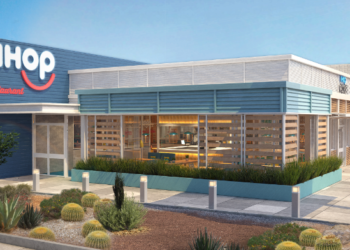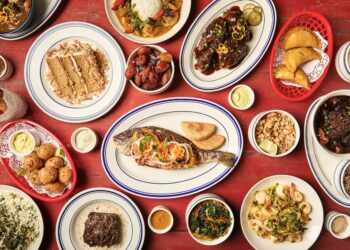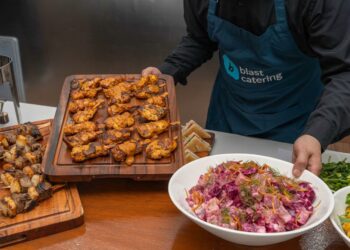As DineEquity’s Regional vice president and general manager Middle East and Asia, Gary Moore, talks exclusively to Catering News ME about a 360 degree rebrand of the iconic IHOP and Applebee’s brands

DineEquity Inc., one of the world’s largest full service restaurant companies and the franchisor of two leading brands in their categories—Applebee’s Grill and IHOP Restaurants—has announced a brand evolution for both restaurants that will include every touch point of the guest experience.
From new creative positioning and advertising campaigns, to remodelled designs, food innovation, service culture, uniform, plates, cups and service items—even the music programming, no stone will be left unturned.
The changes come as DineEquity plans for greater expansion of both brands into the Middle East, which includes recent commitments from multiple existing franchisees to bring an additional 24 Applebee’s restaurants and 17 IHOP restaurants to the region over the next several years.
Over last 18 months DineEquity has carried out consumer research across the globe, interviewing 2,200 consumers across seven different markets, including 600 interviews and four focus groups in the Middle East to gauge customer sentiment on current casual and family dining offerings in order to enhance the model.
Speaking exclusively to Catering News ME, Gary Moore, regional vice president and general manager Middle East and Asia, says: “Within IHOP there was a clear affinity for the brand. After all it is centric to breakfast, which is all about a relaxed, social time with friends and family. People love and remember that experience.
“Applebee’s was different, they felt there was a lot of sameness in the field and little uniqueness. We needed to differentiate the brand so we set about asking why people went to our brand and a lot of it came down to celebrating occasions, like your birthday or your teaming winning, or simply ‘it’s Thursday afternoon’. Applebee’s can be a place for daily celebrations.”
Applebee’s Grill has been serving burgers, steaks, ribs, sandwiches and salads since the first location opened its doors in a suburb of Atlanta Georgia 35 years ago under the name “Applebee’s RX for Edibles and Elixirs”.

Drawing on this heritage, the brand’s evolution is focused around a new positioning: “Applebee’s—There’s always a reason to celebrate”, recognising that there are many occasions to celebrate in life and guests don’t need to wait for a formal occasion such as a birthday or a promotion.
Whereas, the IHOP restaurants draw on more than half a century of expertise and worldwide reputation for offering guests the best in breakfast any time of day, with the new brand creative positioning: “IHOP—Spreading Happiness since 1958.”
In addition to displaying the new IHOP brand logo, which features a prominent smile, IHOP restaurants will also feature new décor, uniforms, menu items, plate ware and culinary innovations that offer a fresh, modern look inspired by IHOP’s origins in 1950’s Southern California.

Moore adds: “We have done a 360 evolution of both brands with a new creative strategy in terms of how we communicate, right down to the plates and how we present a burger – how do we make it more special.
“It has taken us 18 months from deciding what we wanted to be to tying together the concept. We are now building a prototype restaurant of each brand. With our franchisees in the Middle East we are showing them concepts and prototypes like the first new Applebee’s in Porta Rica, which will open in four to five months. We are also building one in the Philippines, and the newest Applebee’s prototype design, “Celebration Time” is expected to be rolled out in the UAE within the next six months.
“While the newest IHOP restaurant prototype design, “California Heritage” is currently under construction in Manila, and is scheduled to open this summer.
“In the UAE we will have a new build on The Point, the new development at The Palm Jumeirah, which is due to open in Q1 2016, as one of the new designs in the region. We will also be building in Kuwait, Saudi Arabia and Qatar within the next year.”
Speaking about the local market, which currently has 42 individual burger chains, Moore says: “The Middle East is extremely competitive now, which is a sign of a healthy economy, but it’s difficult to stand out from the crowd and to be special.
“We have well established franchisees across the Gulf for both brands, people we have worked with for many years. It’s one of our best regions for doing new developments, so we have high expectations of our partners to roll out the new concept.”
Moore says that, in the new restaurant designs, a lot of emphasis has been placed on bringing technology in to the kitchen, to improve the flow and to make the kitchen a theatre for customers. “Rather than back of house the kitchen is now mid house where customers can watch, and there will be a grill master on stage so people can see in.
“A lot of people don’t understand we have chefs cooking fresh food, so we want to show that off. Make that expertise visible.”
Currently serving staff have to go into the kitchen to collect dishes and are therefore out of sight. By moving the kitchen around, and making the grill the lead item into the kitchen, staff can collect dishes directly from the grill without ever being out of sight to the customer. This approach will also make the grill the star of the show.
The same approach was taken with IHOP, making the pancake station central so guests can see the pancakes made fresh for the customer.
Also, within the Middle East the company has tended to build restaurants as they do in the US, complete with a bar, but now there is a realisation that as they don’t serve alcohol it doesn’t have the same gravitas and is dead real estate – so now the bars are being removed from the restaurant. “We still sell the same percentage on drinks in the Middle East as we do in the US, but selling soft drinks are often more profitable,” says Moore.
This year, in the UAE DineEquity will add three Applebees restaurants, one on the Palm, one in Fujairah and one in Dalma Mall in Abu Dhabi, Saudi Arabia will add four, and Kuwait and Qatar one each. For IHOP there will be the first opening in Qatar this year, with an additional unit in Kuwait, and one more in Jeddah, Saudi Arabia.
Moore adds: “There is tremendous growth potential across the Middle East, especially in Saudi Arabia where you have more cities as we find great success in smaller towns.
“Our target markets are families and mostly locals; in Al Ain 90% of our customers are UAE Nationals.”
Both outlets will also be trimming down the menus to make them simpler, while adding a few local specialities, like Arabic omelettes with labneh and pomegranate. So in the future 20% will be localised and 80% signature products from the global menu.
Moore says: “Consumers are now much more likely to customise their dishes, they can flavour any way they want. Next year we will launching a create-your-own steak concept – in terms of the cut, the way its cooks, the sauces and the side dishes. People are much more sophisticated and know want they want.”
The architectural company ABC from Spain worked with DineEquity on the style of uniforms, menus, service and style as well as the restaurant design, and for this rollout the international business will lead the innovation for the domestic US business.
DineEquity Inc. has approximately 3,600 restaurants across both brands including over 220 restaurants outside the United States, throughout the world, including Mexico, Canada, Guatemala, Chile, Brazil, Puerto Rico, Guam, the UAE, Kuwait, Saudi Arabia, Singapore, the Philippines and Indonesia, with plans to focus further expansion of both brands throughout Latin America, the Middle East and Asia. Collectively the group has 27 international franchisees, and in the Middle East there are six for Applebe’es and just one, the Alshaya Group, for IHOP.


































































